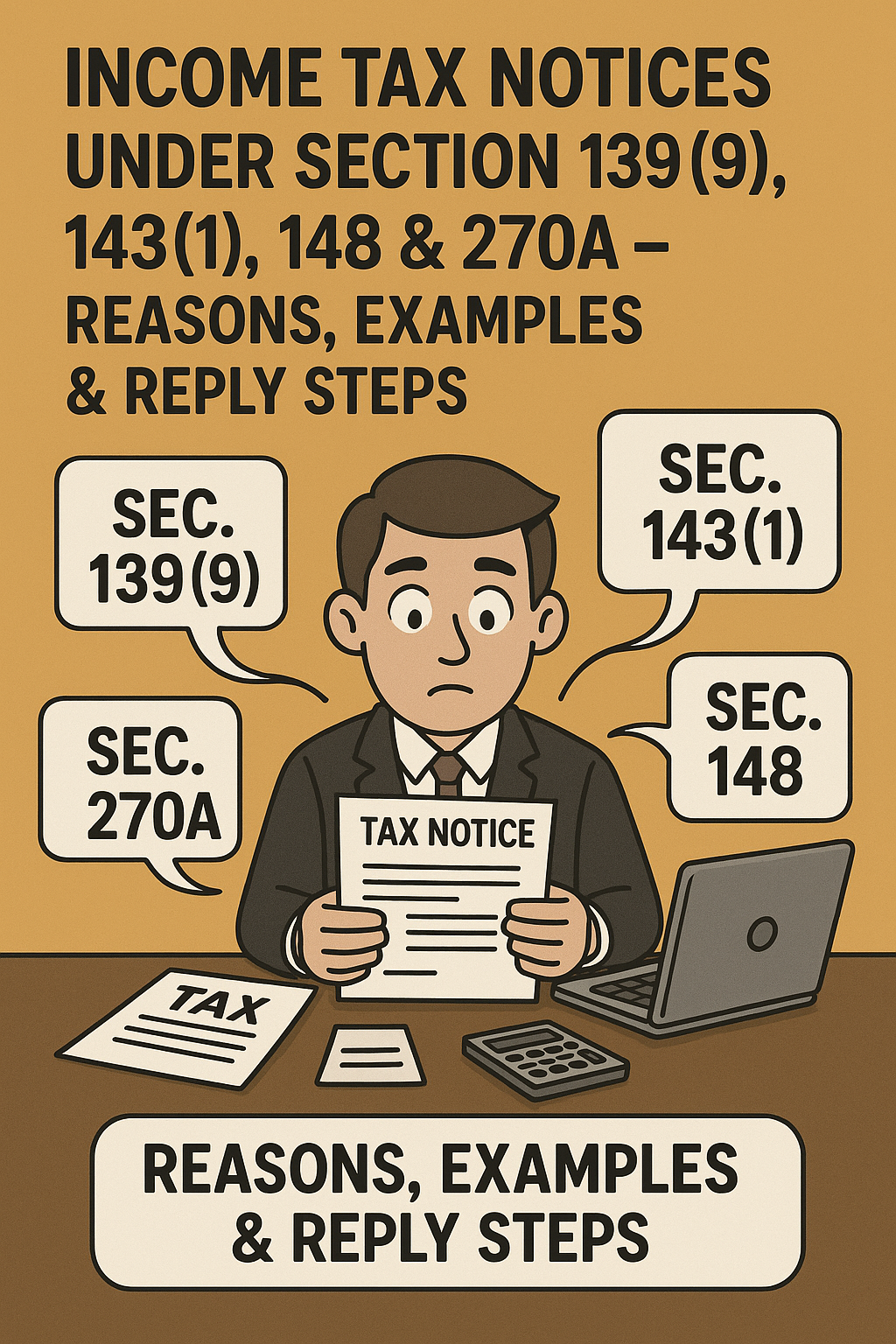If you’ve received an income tax notice — don’t panic! Many honest taxpayers get notices for simple mismatches, calculation mistakes, or documentation issues. In this detailed blog, we will explain everything about Income Tax Notices under Section 139(9), 143(1), 148, and 270A in easy English, with examples, reasons, and how to reply.
Table of Contents
What is an Income Tax Notice?
An income tax notice is a message or letter sent by the Income Tax Department to a taxpayer if there is:
- Any mistake or mismatch in your return
- Non-disclosure of income
- Delay in response or incorrect filing
- Suspected under-reporting of income
Notices can be informative (intimation) or demanding (action required).
Type 1: Notice under Section 139(9) – Defective Return
Meaning:
When your ITR (Income Tax Return) is incomplete or incorrect, it is called defective. You get a notice under Section 139(9) asking you to fix it within 15 days.
Common Reasons:
- Balance Sheet or Profit & Loss not uploaded (for business/professionals)
- TDS claimed but not shown as income
- Claimed loss, but audit report not filed
- Mismatch between income in ITR vs AIS/26AS
Example:
You showed rental income but forgot to show standard deduction or missed showing rent agreement – you may get a 139(9) notice.
How to Reply:
- Log in to www.incometax.gov.in
- Go to e-Proceedings → Submit Response to Notice u/s 139(9)
- Download XML, make corrections in ITR software
- Upload corrected return with proper details
Deadline:
Reply within 15 days of the notice date (extendable by request)
Type 2: Notice under Section 143(1) – Intimation After Processing
Meaning:
This is a system-generated intimation after processing your ITR.
There are 3 types:
- No Demand / No Refund – all OK
- Refund – excess tax paid, refund approved
- Demand – mismatch found, you owe tax
Common Reasons for Demand:
- TDS mismatch with Form 26AS
- Wrong deductions or excess claim
- Interest under Section 234A/B/C
- Typing or calculation mistakes
Example:
You claimed ₹50,000 under 80C, but Form 26AS only shows ₹40,000 – difference of ₹10,000 results in demand.
How to Reply:
- If amount is correct: Pay using Challan 280 and update payment details
- If incorrect: File Rectification Request u/s 154 via portal
Type 3: Notice under Section 148 – Income Escaped Assessment
Meaning:
This is a reopening notice. The department thinks you have not disclosed all your income. It is a serious notice.
Common Triggers:
- High cash deposits not reported
- Property sale but no capital gains shown
- Income from shares, crypto, FD not disclosed
- Foreign remittance or assets not declared
Example:
You sold land worth ₹40 lakh but didn’t report it in ITR. The Income Tax dept receives this from SFT (Statement of Financial Transactions) and sends 148 notice.
Time Limits:
- Within 3 years for small issues
- Up to 10 years if income > ₹50 lakh is hidden
How to Reply:
- Login to portal > Pending Actions > e-Proceedings
- Submit response with explanations and documents
- File updated ITR or reply to show income was already reported
Note: You can also file ITR-U (Updated Return) if eligible to avoid penalty.
Type 4: Notice under Section 270A – Penalty for Under-Reporting
Meaning:
This notice is issued when the tax officer believes that you under-reported or misreported your income.
Penalty Details:
- 50% of tax payable = For under-reporting
- 200% of tax payable = For misreporting (fake bills, wrong deduction)
Situations:
- Not showing capital gains
- Claiming deduction without proof
- Not reporting bank interest or foreign income
Example:
You show ₹5 lakh salary but don’t report ₹1.5 lakh interest income – this could be under-reporting.
How to Reply:
- Submit explanation through e-filing portal
- Upload documents proving genuineness
- If wrongly penalised – file appeal to CIT(A) or ITAT
How to Avoid Income Tax Notices?
- File ITR correctly and before the due date
- Cross-check AIS, TIS, and Form 26AS before filing
- Don’t claim deductions or exemptions without proof
- Show even small incomes like interest or freelance work
- Take professional help if you have complex income or multiple sources
Final Words
Getting a notice under Section 139(9), 143(1), 148 or 270A doesn’t always mean something is wrong. Most notices are routine and can be resolved online if you respond on time with accurate information. Always maintain your tax records and consult a tax expert if unsure.
Conduct Taxgiveindia.com for filling notices reply and others services.
